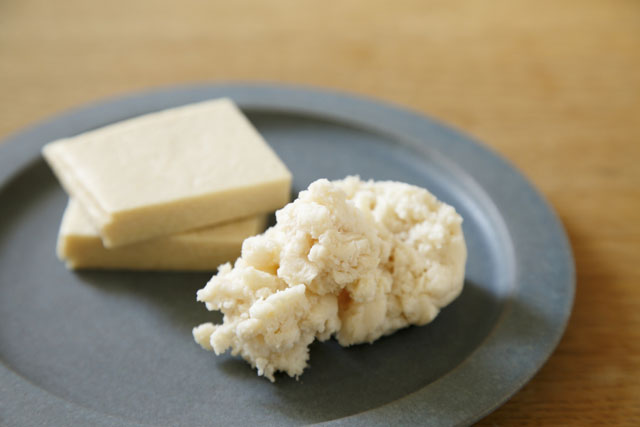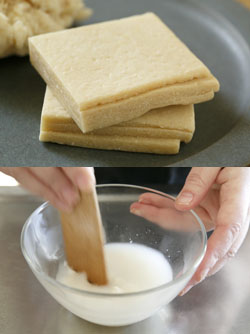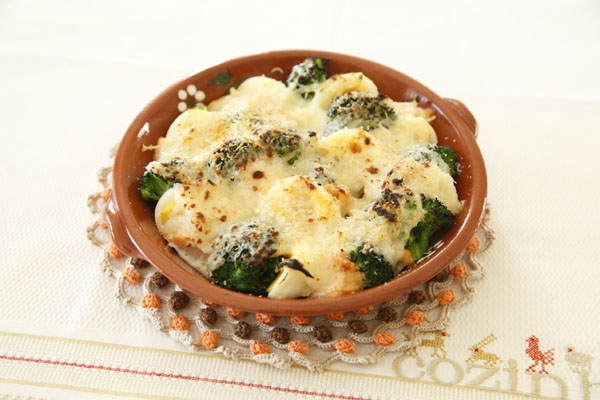Sake Lees & Sake Kasu: Fermented Flavor in Daily Cooking
Jan 10,2014
Sake Lees & Sake Kasu: Fermented Flavor in Daily Cooking
Jan 10,2014
Regular Japanese meals have long been enriched by many fermented foods including miso, soy sauce, vinegar, mirin rice wine, and fermented natto soybeans. Fermented foods and their umami flavorings are produced by the actions of endemic microorganisms and offer a host of benefits to the human body. Fermented foods, moreover, contain the hard-earned wisdom of our ancestors and are deserving to be passed on to future generations. In this series, we will present recipes that are easy to incorporate into today’s lifestyles while getting at the essence of fermented foods.
In Part 3, we look at saké lees, the base of kasujiru soup that heats the body in the cold winter months.
▶Shio Koji, Salted Koji & Japanese Food with a Koji-ya
▶Nukazuke Pickles: Simple Joys of Rice Bran Fermentation


Saké lees is a byproduct of the saké brewing process. Saké lees has been enjoyed since antiquity — it even appears in the Manyoshu collection of classical Japanese poetry — and in recent years, it has experienced a resurgence in popularity as a fermented food with both health and beauty benefits. We spoke with Kuriyama Mayumi, a cooking expert who is so fascinated with saké lees that she has even published cookbooks of saké lees recipes.
“Saké lees is the leftover solids produced when making saké. The liquid pressed out of the fermented moromi mash, which is made from rice, koji malt, and water, is the saké, while the remaining solids are saké lees. Saké lees used to be eaten in areas local to saké breweries, but the majority of it was simply disposed of. However, there is no reason not to use it, since it is healthy and packed with umami.”
Saké lees is highly nutritional, as it has an excellent balance of vitamins, minerals, proteins, and dietary fiber. It has outstanding beauty benefits, containing arbutin, a good skin-lightening agent, and various amino acids that promote moisturization. Moreover, saké lees purportedly helps regulate the gut microbiome. Kuriyama became hooked on saké lees when she experienced firsthand how good it was for her physical condition.
“I used to suffer from poor circulation and lowered metabolism. But then I remembered when I was young how warm my body felt after eating meals my mother prepared using saké lees. When I tried some saké lees, my body stayed warm all the way through to bedtime. There are other foods that warm you only during the time you eat them, but it’s rare to find something with the staying power of saké lees. Boosting your metabolism leads to more lustrous skin and helps you lose weight too. You’ll probably notice the effects even more if you use saké lees in hot dishes like soups.”
Besides its health benefits, another appealing point for saké lees is how it makes food taste better. The yeast in saké lees acts to bring out the umami of ingredients and deepens their flavors.
“People might think saké lees is suited only for Japanese cooking, but it can be used in all kinds of foods, including Western dishes, Chinese dishes, ethnic cuisine, bread, and confectionary. You can substitute saké lees for milk to make white béchamel sauce or make carbonara sauce with eggs and saké lees and omit the fresh cream. Saké lees has a light taste but with enough body that it doesn’t feel lacking in any way, and it helps cut calories. Because it adds umami, I recommend it to people who are trying to cut down on their salt intake. It does, however, contain alcohol, so it should be used with caution when preparing meals for pregnant women and children.”
You can create a saké lees pickling bed by adding seasonings to it for convenient pickling of fish or vegetables in saké lees. This traditional preparation method both heightens the umami of ingredients and extends their shelf life. Saké lees is often associated with the winter months, but it is useful year-round because it has remarkable sterilizing efficacy.
The recommendation for people new to saké lees is to add a little of it to their regular dishes. Try dissolving some in miso soup, in dipping sauces for udon or soba noodles, or in oden stews, or mixing it in with natto [fermented soybeans] or kimchi. The saké lees will boost the flavor and take the taste to the next level. Using saké lees — the wisdom of our ancestors — will give you a healthier body and enrich your dining table. You will notice its depth with just a bite.

Recipe for saké lees soup with tofu and nameko mushrooms

Ingredients (two-person serving)
Saké lees……30grams
Tofu……Quarter of a block
Nameko mushrooms……One package
Daikon radish sprouts……Quarter of a package
Dashi stock……Two cups
Miso……One tablespoon
Directions
1.Cut the tofu into one-centimeter cubes. Pour boiling hot water over the nameko mushrooms in advance. Cut off the roots of the daikon radish sprouts and then cut in half.
2.Bring the dashi stock to a boil in a small pot, then add the tofu and nameko mushrooms and simmer for two to three minutes.
3.Turn off the heat from Step 2, dissolve the saké lees and miso in the cooking stock, and add it back to the pot. Simmer again for one to two minutes over a medium heat. Add the daikon radish sprouts and serve in bowls.
Recipe for creamy saké lees gratin

Ingredients (two-person serving)
Saké lees……30grams
Fresh salmon……Two fillets
Hard-boiled eggs……Two
Broccoli……1/2 a head
Onion……1/4
Butter……One tablespoon
Flour……One tablespoon
Grated cheese and breadcrumbs……As needed
Salt and pepper……To taste
Directions
1.Remove the skin and bones from the salmon, cut into bite-sized pieces, and sprinkle with a little salt and pepper. Separate the broccoli into small florets and boil in advance. Cut the onion into thin slices. Dissolve the saké lees in a third of a cup of hot water (not listed in the ingredients).
2.Oil the inside of a gratin dish with a thin layer of butter and arrange the salmon and broccoli from Step 1 in the dish.
3.Melt the butter in a small frypan and sauté the onion over a low heat. When the onion has softened, turn the heat off and mix in the flour. Turn the heat on again and sauté the mixture over a low heat. When it has cooked, add the saké lees. Mix to keep an even consistency until it thickens, and then stir in half a teaspoon of salt and a little pepper. Once it comes to a boil, pour the mixture over the ingredients in the gratin dish in Step 2. Sprinkle with the grated cheese and breadcrumbs and bake in a preheated toaster for eight to nine minutes.
A word of caution about saké lees
Saké lees does contain alcohol. The alcohol will evaporate when heated, but caution should be used when preparing saké lees meals for pregnant women, children, and others sensitive to alcohol.

Kuriyama worked at an office job and as an assistant chef after graduating from college, before going freelance. She has a reputation for simple, healthy recipes that bring out the natural flavors of ingredients. Her activities mainly focus on magazines and books. Known for her love of travel, she runs a cooking school called Amigos Deliciosos centered on Portuguese cuisine. Kuriyama is the author of numerous books including Super Practical Saké Lees Recipes (Ie-no-Hikari Association) and Nine p.m. Dinner for Everyone (Shinsei Publishing).